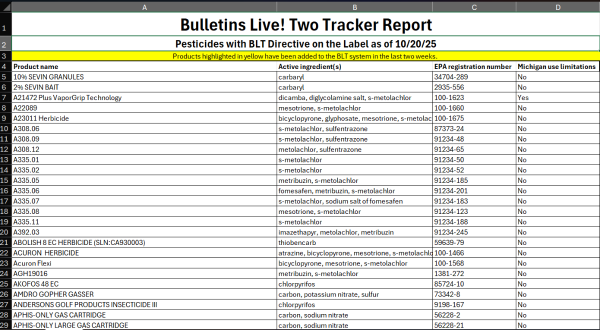
Bulletins Live! Two Tracker Report
DOWNLOADNovember 20, 2025 - Erin Lizotte, Michigan State University Extension; Heather Borden, Michigan State University Extension; and Safa Alzohairy, Pesticide Safety Education Program
It can be difficult for applicators to stay up to date on changes to Bulletins Live! Two (BLT) that impact pesticide label directives and in some cases, involve additional pesticide use limitations. To help raise awareness of ongoing changes, Michigan State University Extension is generating a biweekly BLT Tracker Report that lists pesticide products that currently require applicators to use the BLT system and highlights products with pesticide use limitations in Michigan.
Applicators should keep the following in mind when using the BLT Tracker Report:
- The report is a tool intended to raise awareness of changes in the BLT system but cannot be relied upon to make pesticide application decisions. Always refer to the pesticide label and BLT website to verify the accuracy of information.
- Follow the directions attached to the pesticide container in hand. There will be instances when a pesticide has been added to the BLT website, but existing product with an old label is still in the supply chain. The label attached to the product should be followed.
- Applicators are responsible for checking pesticide labels for the BLT directive in the "Directions for Use" section and visiting the BLT website if required by the label.
- To view a live list of products impacted by pesticide use limitations by county, visit https://www.epa.gov/endangered-species/data-download. Please note this will only return products with pesticide use limitation within the selected county and does not include the full list of products that will require applicators to visit the BLT website. To check a specific application site and timing, applicators must visit the BLT website and enter their application parameters.
For additional resources related to Bulletins Live! Two, visit the MSU Extension website or the EPA website.
Please consider taking a brief feedback survey on our Bulletins Live! Two resources. Your insight is critical to improving MSU efforts to support stakeholders. All questions are optional and your responses are confidential.
This project is supported by Project GREEEN, project award number GR25-052, from AgBioResearch and MSU Extension at Michigan State University, in partnership with the Michigan Department of Agriculture and Rural Development.
This project was funded in part by the USDA National Institute of Food and Agriculture, through the Western Integrated Pest Management Center, and is also supported by the Crop Protection and Pest Management Program (grant no 2024-70006-43569) from the USDA National Institute of Food and Agriculture. Any opinions, findings, conclusions, or recommendations expressed in this publication are those of the author(s) and do not necessarily reflect the view of the U.S. Department of Agriculture.



 Print
Print Email
Email

